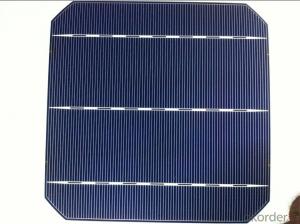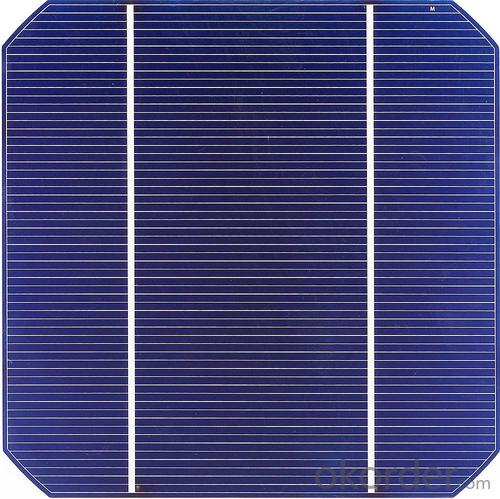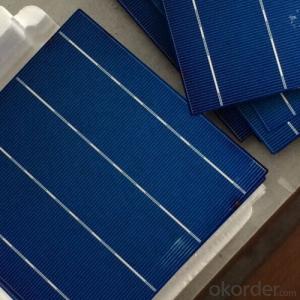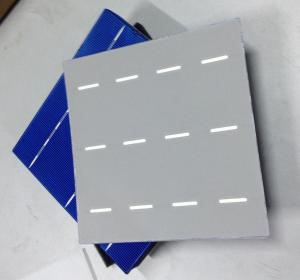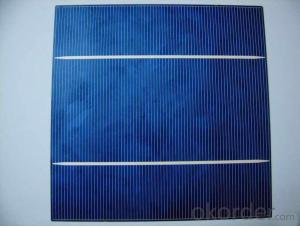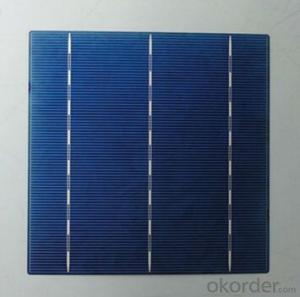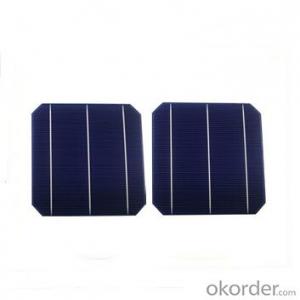Roll To Roll Monocrystalline Solar Cells - Tire 1 Manufacturer - 18% Efficiency
- Loading Port:
- Shanghai
- Payment Terms:
- TT OR LC
- Min Order Qty:
- 10000 pc
- Supply Capability:
- 50000000 pc/month
OKorder Service Pledge
OKorder Financial Service
You Might Also Like
Specifications of Mono Solar Cells
Format : 156 mm × 156 mm ± 0.5 mm
Thickness: 210 μm ±40 μm
Front (-) : 1.5mm bus bars (silver),blue anti-reflection coating (silicon nitride)
Back (+) : 2.5mm wide soldering pads (silver) back surface field (aluminium)
Electrical Characteristic of Mono Solar Cells
Efficiency (%) | Pmpp (W) | Umpp (V) | Impp (A) | Uoc (V) | Isc (A) | FF (%) |
18.35 | 4.384 | 0.526 | 8.333 | 0.63 | 8.877 | 78.39% |
18.20 | 4.349 | 0.526 | 8.263 | 0.63 | 8.789 | 78.54% |
18.05 | 4.313 | 0.525 | 8.216 | 0.63 | 8.741 | 78.32% |
17.90 | 4.277 | 0.524 | 8.161 | 0.629 | 8.713 | 78.04% |
17.75 | 4.241 | 0.523 | 8.116 | 0.629 | 8.678 | 77.70% |
17.60 | 4.206 | 0.521 | 8.073 | 0.628 | 8.657 | 77.36% |
17.45 | 4.170 | 0.519 | 8.039 | 0.628 | 8.633 | 76.92% |
17.30 | 4.134 | 0.517 | 8.004 | 0.626 | 8.622 | 76.59% |
17.15 | 4.098 | 0.516 | 7.938 | 0.625 | 8.537 | 76.80% |
17.00 | 4.062 | 0.512 | 7.933 | 0.625 | 8.531 | 76.18% |
16.75 | 4.002 | 0.511 | 7.828 | 0.625 | 8.499 | 75.34% |
16.50 | 3.943 | 0.510 | 7.731 | 0.625 | 8.484 | 74.36% |
Advantage of Polycrystalline Solar Cells
1. Tire-1 Solar Cells’ Manufacturer Quality Guarantee. With a complete and sophisticated quality government system, our Quality Management have arrived world’s leading place. Customer can receive Tire-1 Cells Maker’s Quality Standard Products.
2. Trusted Warranty. We can supply trusted after-sales service to our customer. If our cells are found not in conformity to the specification of manufacturer, or should the inspected quantity found in shortage, or should the packing found damaged, the buyer has the right to claim to the seller. The claim, if any, should be presented to seller within 30 days after cargo's arrival date to the port, together with related inspection report and photos issued and provided by a reputable independent surveyor such as SGS.
3. World’s Leading Manufacturer Equipment. We imported the newest and leading production equipment from abroad. Advanced equipment can guarantee the stable quality of cells. Auto production line can also save labor cost which will further cut our production cost.
4. Bulk supply: With the production capacity of 500MW, we can produce large quantity every month. This can satisfy most customer requirement.
Usage of Polycrystalline Solar Cells
Solar cells are often electrically connected and encapsulated as a module. Photovoltaic modules often have a sheet of glass on the front (sun up) side, allowing light to pass while protecting the semiconductor wafers from abrasion and impact due to wind-driven debris, rain, hail, etc. Solar cells are also usually connected in series in modules, creating an additive voltage. Connecting cells in parallel will yield a higher current; our solar cells have passed IEC Certification. With high and stable quality, our cells can greatly improve the performance of Solar Modules.
Applications of Polycrystalline Solar Cells
Assemblies of photovoltaic cells are used to make solar modules which generate electrical power from sunlight, as distinguished from a "solar module" or "solar panel". A solar array generates solar power using solar energy.
Packaging & Delivery of Polycrystalline Solar Cells
Carton Box Package and Deliver by air. It should be noticed that it should be avoid of water, sunshine and moist.
Factory Picture of Solar Cells
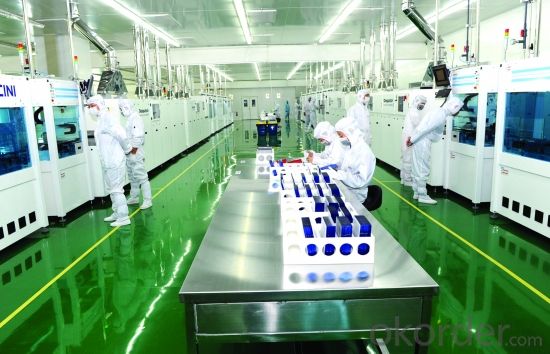


FAQ
We have organized several common questions for our clients,may help you sincerely:
1. What’s price per watt?
A: It’s depends on the quantity, delivery date and payment terms of the order. We can talk further about the detail price issue. Our products is high quality with lower price level.
2. Can you tell me the parameter of your solar cells?
We have different series of cells with different power output, both from c-si to a-si. Please take our specification sheet for your reference.
3. How do you pack your products?
We have rich experience on how to pack the panels to make sure the safety on shipment when it arrives at the destination.
4. Can you do OEM for us?
Yes, we can.
5. How long can we receive the product after purchase?
In the purchase of product within three working days, We will arrange the factory delivery as soon as possible. The perfect time of receiving is related to the state and position of customers. Commonly 7 to 10 working days can be served.
- Q: How do solar cells perform in areas with high levels of vibration?
- Solar cells generally perform well in areas with high levels of vibration. The cells are designed to be sturdy and resistant to vibrations, ensuring their longevity and efficiency. However, it is essential to ensure proper installation and maintenance to minimize any potential damage or displacement caused by excessive vibrations.
- Q: Can solar cells be used for powering water treatment plants?
- Yes, solar cells can be used for powering water treatment plants. Solar energy can be harnessed and converted into electricity to power the various processes and equipment required for water treatment. This renewable energy source offers a sustainable and environmentally friendly solution for powering water treatment plants.
- Q: Can solar cells be used to power medical devices or implants?
- Yes, solar cells can be used to power medical devices or implants. They can provide a renewable and sustainable source of energy for various medical applications, including implants such as pacemakers, insulin pumps, and hearing aids. By utilizing solar energy, these devices can operate without relying on traditional batteries or frequent replacements, offering patients greater convenience and reducing the need for invasive procedures.
- Q: Can solar cells be used in electric bikes or scooters?
- Yes, solar cells can be used in electric bikes or scooters to harness the sun's energy and convert it into electricity to power the vehicles. By incorporating solar panels, these vehicles can become more sustainable and reduce their dependence on traditional energy sources.
- Q: Doping and Diffusion Principle in Solar Cell Processing
- In some inorganic solid compounds doped with different metal ions, can be different properties of luminescent materials, such as yttrium oxide (III) doped with europium (III) ions can be red fluorescent materials.
- Q: Can solar cells be used in aircraft applications?
- Yes, solar cells can be used in aircraft applications. They are commonly used in solar-powered aircraft to convert sunlight into electrical energy, which can then be used to power the aircraft's systems and/or charge its batteries. Solar cells can help reduce the reliance on fossil fuels, increase flight time, and contribute to more sustainable aviation.
- Q: Can solar cells be used in water?
- Yes, solar cells can be used in water. Some solar panels are specifically designed to be used in water environments, such as floating solar panels used in reservoirs, lakes, and other bodies of water. These panels are waterproof and can efficiently generate electricity even when partially submerged.
- Q: How do solar cells perform in areas with high levels of salt spray?
- Solar cells generally do not perform well in areas with high levels of salt spray. The salt particles can accumulate on the surface of the solar cells, reducing their efficiency by blocking sunlight and corroding the electrical components. Regular cleaning and maintenance are required to mitigate the negative impacts of salt spray on solar panels in such areas.
- Q: Can solar cells be used to power water treatment plants?
- Yes, solar cells can be used to power water treatment plants. Solar energy can be converted into electricity using photovoltaic technology, which can then be utilized to power the various systems and processes involved in water treatment, such as pumps, filters, and disinfection systems. Solar power offers a sustainable and environmentally friendly solution for powering water treatment plants, particularly in areas with abundant sunlight.
- Q: What is the history of solar cell development?
- The history of solar cell development dates back to the 19th century when French physicist Alexandre-Edmond Becquerel discovered the photovoltaic effect, which is the basis for solar cell technology. However, it was not until the 1950s that the first practical solar cells were developed, primarily for use in space exploration. Over the years, advancements in materials and manufacturing techniques have led to improved efficiency and affordability of solar cells. Today, solar cells are widely used to generate clean and renewable energy for various applications, ranging from powering homes and buildings to providing electricity in remote areas. Ongoing research and development continue to push the boundaries of solar cell technology, aiming to enhance efficiency, durability, and accessibility to harness the sun's energy more effectively.
Send your message to us
Roll To Roll Monocrystalline Solar Cells - Tire 1 Manufacturer - 18% Efficiency
- Loading Port:
- Shanghai
- Payment Terms:
- TT OR LC
- Min Order Qty:
- 10000 pc
- Supply Capability:
- 50000000 pc/month
OKorder Service Pledge
OKorder Financial Service
Similar products
Hot products
Hot Searches
Related keywords


